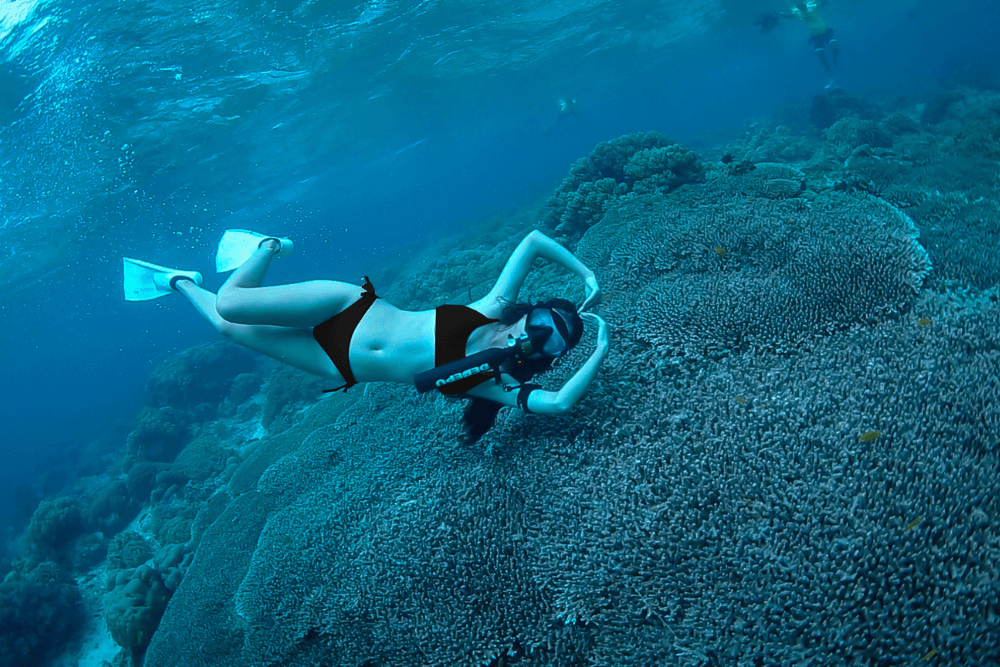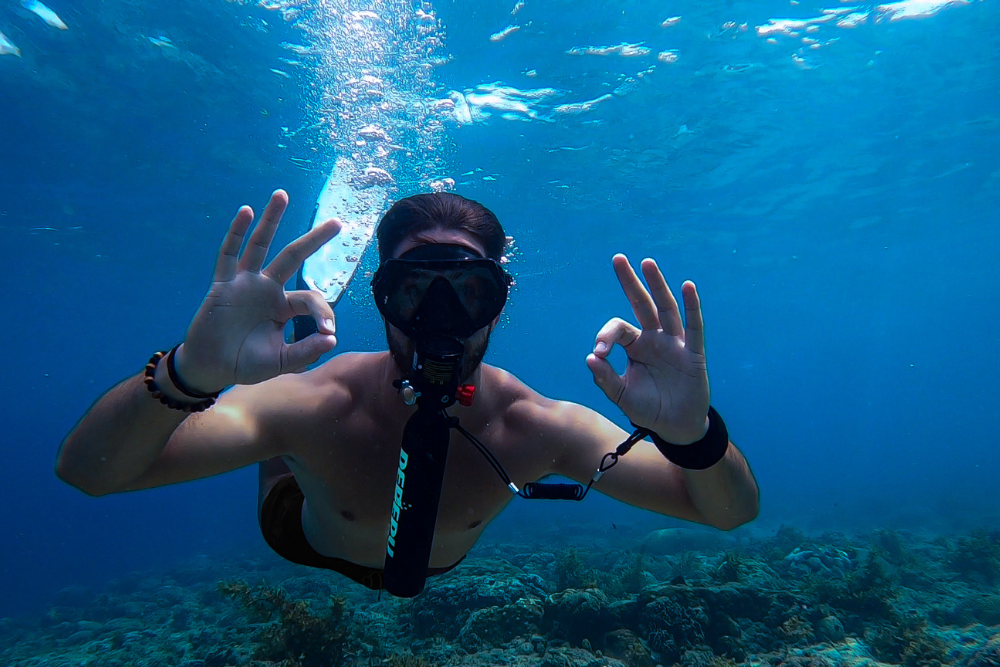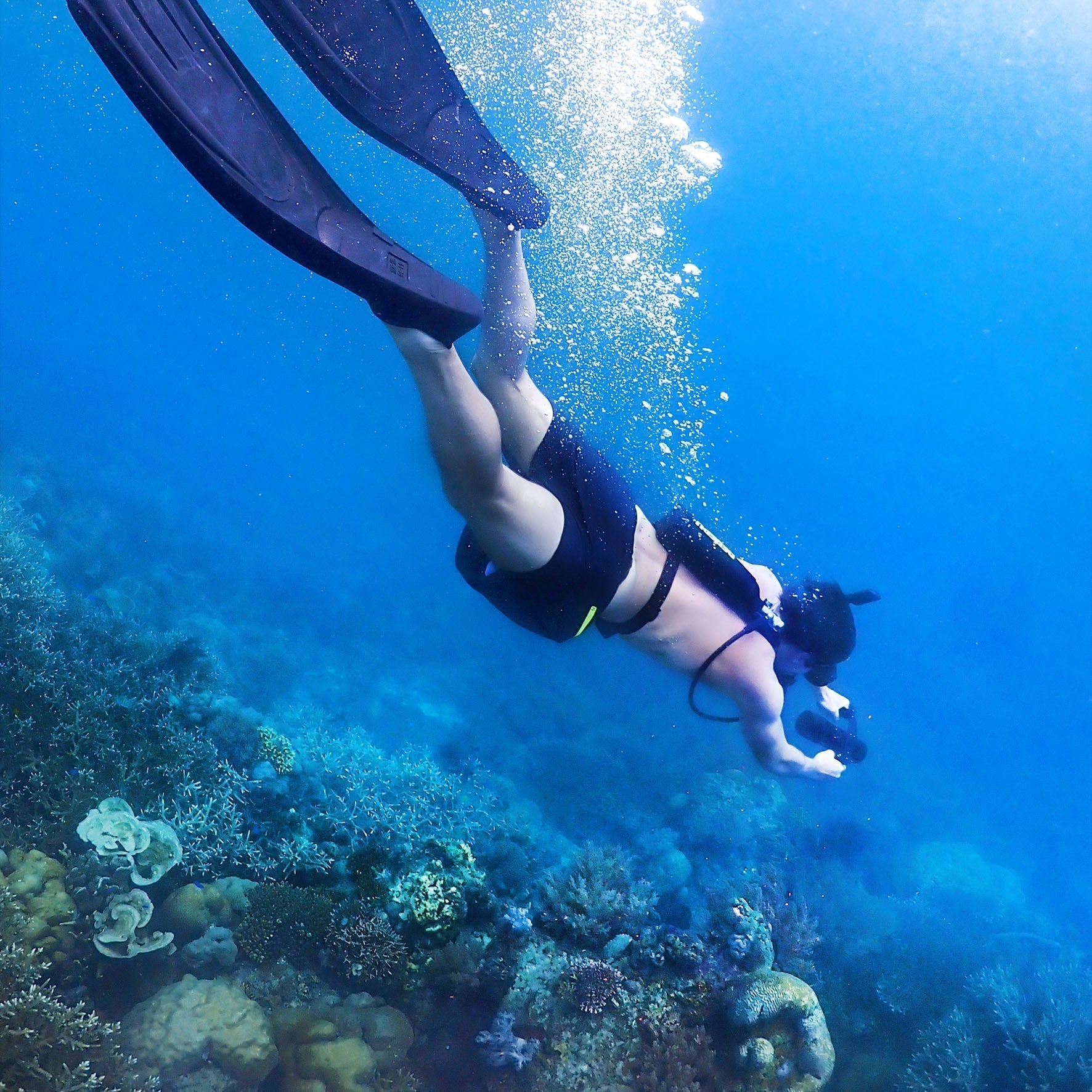Scuba diving requires careful weight management for safety and comfort underwater. A standard aluminum 80-cubic-foot (11.1L) tank weighs about 31 lbs (14 kg) when full, while a similar-sized steel tank can be 5-10 lbs (2.3-4.5 kg) heavier. The air inside adds 4-6 lbs (1.8-2.7 kg)—meaning an empty tank is noticeably lighter. Divers using aluminum tanks often need 4-8 lbs (1.8-3.6 kg) more weight than those with steel.
Tank Materials
A typical aluminum 80-cubic-foot (AL80) tank weighs 31.4 lbs (14.2 kg) when full, but only 17.2 lbs (7.8 kg) empty. In contrast, a steel 80-cubic-foot (HP80) tank weighs 33.5 lbs (15.2 kg) full and 28.5 lbs (12.9 kg) empty. That means steel tanks are 66% heavier when empty, but only 7% heavier when full due to their thicker walls.
Aluminum tanks are popular because they’re lighter on land (about 30% easier to carry), but they float more as they empty—requiring 4-8 lbs (1.8-3.6 kg) of extra lead weight to stay neutral. Steel tanks sink slightly even when empty, so divers often need 2-4 lbs (0.9-1.8 kg) less weight overall. Durability also differs: aluminum tanks last 20-30 years with proper care, while steel tanks can go 30-40 years but need more maintenance to prevent rust.
1. Weight Comparison: Full vs. Empty
Aluminum (AL80):
Full weight: 31.4 lbs (14.2 kg)
Empty weight: 17.2 lbs (7.8 kg)
Weight loss when empty: 14.2 lbs (6.4 kg) → This makes the tank more buoyant as you dive.
Steel (HP80):
Full weight: 33.5 lbs (15.2 kg)
Empty weight: 28.5 lbs (12.9 kg)
Weight loss when empty: 5 lbs (2.3 kg) → Stays closer to neutral buoyancy.
Takeaway: If you hate adjusting buoyancy mid-dive, steel is more stable. If you prefer a lighter tank above water, aluminum wins.
2. Buoyancy Shift During the Dive
Aluminum tanks gain ~4 lbs (1.8 kg) of buoyancy by the end of a dive.
Steel tanks gain only ~1 lb (0.45 kg) of buoyancy.
This means aluminum divers often need 2-4 lbs (0.9-1.8 kg) more lead to compensate.
3. Durability & Maintenance Costs
Aluminum tanks last 20-30 years, cost 250-400 new, and need minimal upkeep.
Steel tanks last 30-40 years but cost 350-600 new and require annual visual inspections + hydro tests every 5 years to prevent corrosion.
Choose aluminum if you want a lightweight, low-maintenance tank and don’t mind extra lead.
Choose steel if you prefer stability underwater and are okay with higher upfront costs.

Tank Size Matters
A standard AL80 (80 cubic feet / 11.1L) tank weighs 31.4 lbs (14.2 kg) full, while a larger AL100 (100 cu ft / 13.8L) jumps to 38.5 lbs (17.5 kg). That’s a 23% increase in weight for just 25% more air.
But it’s not just about total weight. Bigger tanks displace more water, changing how you float. An empty AL100 has 20% more buoyancy than an AL80, meaning you’ll need 5-7 lbs (2.3-3.2 kg) extra lead to stay neutral at the end of a dive. Steel tanks follow the same trend: a HP100 (100 cu ft) weighs 41.2 lbs (18.7 kg) full—11% heavier than an HP80—but its thicker walls reduce buoyancy shift.
1. Weight vs. Air Supply: Is Bigger Always Better?
AL80 (80 cu ft / 11.1L):
Full weight: 31.4 lbs (14.2 kg)
Air duration: ~60 mins (avg. diver at 30 ft / 9 m)
AL100 (100 cu ft / 13.8L):
Full weight: 38.5 lbs (17.5 kg) (+23%)
Air duration: ~75 mins (+25%)
HP100 (100 cu ft):
Full weight: 41.2 lbs (18.7 kg)
Air duration: ~80 mins (steel tanks retain pressure better)
Takeaway: A 25% larger tank gives 25% more dive time but adds 20-23% more weight. For short dives, the AL80 is easier to handle. For longer dives, the AL100 or HP100 may justify the extra load.
2. Buoyancy Shift: How Tank Size Changes Your Trim
Floatiness when empty:
AL80: Gains +4 lbs (1.8 kg) buoyancy
AL100: Gains +5.5 lbs (2.5 kg) buoyancy (+38%)
HP100: Gains only +1.5 lbs (0.7 kg) (steel resists buoyancy shift)
Lead needed:
Divers using an AL100 typically need 6-8 lbs (2.7-3.6 kg) vs. 4-6 lbs (1.8-2.7 kg) for an AL80.
3. Physical Comfort & Logistics
Larger tanks (AL100/HP100):
Are 2-3 inches (5-7.6 cm) taller, which can affect balance on boats.
Require stronger backplates (e.g., stainless steel) to support the weight.
Cost 50-150 more than standard AL80s.
Why a Full Tank Feels Heavier
A full AL80 tank (80 cu ft / 11.1L) holds 2.3 kg (5.1 lbs) of compressed air, which is 16% of its total weight (14.2 kg / 31.4 lbs). That means by the time you surface, your tank has shed over 5 lbs—enough to throw off your buoyancy if you don’t adjust.
Steel tanks behave differently. A HP100 (100 cu ft) loses just 1.4 kg (3.1 lbs) of air weight—only 8% of its total mass (18.7 kg / 41.2 lbs)—because steel’s thicker walls account for more of the weight. This explains why steel divers need less lead adjustment during a dive compared to aluminum users.
1. The Math: How Much Does Compressed Air Weigh?
Air density at sea level: 1.225 kg/m³ (0.00238 lbs/L)
Inside a 3000 PSI scuba tank:
Air is compressed to ~200x normal density.
AL80 (11.1L tank): Holds 2.3 kg (5.1 lbs) of air when full.
HP100 (13.8L tank): Holds 2.8 kg (6.2 lbs) of air when full.
Weight loss per 500 PSI drop:
AL80: ~0.38 kg (0.84 lbs) per 500 PSI.
HP100: ~0.47 kg (1.03 lbs) per 500 PSI.
Takeaway: An AL80 diver loses 1.5 lbs (0.68 kg) of air weight in the first 10 minutes (assuming 1 PSI/min consumption at 30 ft). That’s why buoyancy control is hardest at the start of a dive.
2. Buoyancy Shift: Why Your Tank Floats More as You Breathe
Empty AL80:
Weighs 7.8 kg (17.2 lbs) in air.
Displaces 11.1L of water → 11.1 kg (24.5 lbs) of buoyant force.
Net buoyancy when empty: +3.3 kg (7.3 lbs) (it floats!).
Empty HP100:
Weighs 12.9 kg (28.5 lbs) in air.
Displaces 13.8L of water → 13.8 kg (30.4 lbs) buoyant force.
Net buoyancy when empty: +0.9 kg (2 lbs) (nearly neutral).
Practical impact:
Aluminum divers must add 4-6 lbs (1.8-2.7 kg) of lead to offset the tank’s floatiness.
Steel divers often need just 2-3 lbs (0.9-1.4 kg) because the tank stays negative longer.
3. Real-World Adjustment: How to Compensate
At the start of a dive:
With a full AL80, you’re 5 lbs (2.3 kg) heavier than at the end.
Add air to your BCD early to avoid sinking too fast.
At 500 PSI remaining:
An AL80 has lost 4.4 lbs (2 kg) of air weight.
Dump BCD air progressively to maintain neutral buoyancy.
Pro tip: Steel tank users can wait longer to adjust their BCD—their buoyancy shifts 50% slower than aluminum divers.
How Tanks Change Your Setup
A standard lead weight belt carries 5-10 lbs (2.3-4.5 kg) per side, but shifts during the dive as your tank's buoyancy changes. Meanwhile, integrated weights (like BCD pockets) keep 8-12 lbs (3.6-5.4 kg) fixed closer to your torso, improving trim—especially with floaty aluminum tanks.
Here's the catch: steel tank divers often need 30-40% less weight than aluminum users, changing the math completely. An AL80 setup might require 10 lbs (4.5 kg) on a belt, while the same diver with an HP100 could drop to 6 lbs (2.7 kg)—making integrated weights more practical. Costs vary too: weight belts run 20-50, while integrated systems add 100-200 to your BCD price.
1. Weight Distribution: How Tank Type Affects Placement
Aluminum Tanks (Buoyant):
Need 8-12 lbs (3.6-5.4 kg) total, usually split:
4-6 lbs (1.8-2.7 kg) on a belt (for quick ditching).
2-4 lbs (0.9-1.8 kg) in trim pockets (near shoulders/tank).
Problem: Belts slide down as the tank floats up during ascent.
Steel Tanks (Negative):
Need 4-8 lbs (1.8-3.6 kg) total, often all integrated:
2-3 lbs (0.9-1.4 kg) in BCD side pockets.
1-2 lbs (0.45-0.9 kg) on cam bands (tank-mounted).
Advantage: Weight stays centered, reducing roll.
Data point: Divers using aluminum tanks with weight belts report 27% more buoyancy instability during safety stops vs. integrated systems.
2. Cost & Convenience Tradeoffs
| System | Price Range | Best For | Drawbacks |
|---|---|---|---|
| Weight Belt |
20-50 |
Budget divers | Slides down, hard to adjust mid-dive |
| BCD Pockets |
100-200* |
Aluminum tank users | Adds bulk to BCD |
| Tank Weights |
30-80 |
Steel tank divers | Limited to 2-4 lbs (0.9-1.8 kg) |
*Added to BCD cost
Pro tip: If you dive both tank types, hybrid systems (like belt + 2 lbs in trim pockets) work best.
3. Real-World Performance Metrics
Time to ditch weights:
Belts: 2-3 seconds (critical in emergencies).
Integrated: 5-8 seconds (must release multiple clips).
Streamlining:
Integrated setups reduce drag by 15-20% vs. dangling belts.
Comfort:
68% of divers report less lower back strain with integrated weights.
Case study: A diver using an AL80 + 10 lbs belt switched to 8 lbs integrated and cut their air consumption by 7% from improved trim.

Weight & Performance Compared
An AL80 (the rental standard) weighs 31.4 lbs (14.2 kg) full but becomes a 7.3 lb (3.3 kg) float when empty. Compare that to a steel HP117—49.2 lbs (22.3 kg) full, yet still -2.2 lbs (-1 kg) negative when empty. That's a 9.5 lb (4.3 kg) swing in end-of-dive buoyancy between these two tanks holding similar air volumes.
1. Aluminum AL80 (80 cu ft)
Full Weight: 31.4 lbs (14.2 kg)
Empty Weight: 17.2 lbs (7.8 kg)
Buoyancy Shift: +7.3 lbs (3.3 kg)
Lead Needed: 8-10 lbs (3.6-4.5 kg)
Best For: Warm water divers doing <60 min dives
2. Steel HP100 (100 cu ft)
Full Weight: 41.2 lbs (18.7 kg)
Empty Weight: 28.5 lbs (12.9 kg)
Buoyancy Shift: +1.1 lbs (0.5 kg)
Lead Needed: 4-6 lbs (1.8-2.7 kg)
Best For: Cold water or tech divers needing stability
3. Aluminum S121 (121 cu ft)
Full Weight: 45.6 lbs (20.7 kg)
Empty Weight: 24.3 lbs (11 kg)
Buoyancy Shift: +9.5 lbs (4.3 kg)
Lead Needed: 12-14 lbs (5.4-6.4 kg)
Warning: Requires strong backplate for 50+ min dives
4. Steel LP85 (85 cu ft)
Full Weight: 37.6 lbs (17.1 kg)
Empty Weight: 31.9 lbs (14.5 kg)
Buoyancy Shift: -0.8 lbs (-0.36 kg)
Lead Needed: 2-4 lbs (0.9-1.8 kg)
Hidden Gem: Perfect balance for photographers
Air Consumption Impact:
Divers using buoyant tanks (AL80/S121) burn 5-8% more air from constant buoyancy adjustments
Dive Duration Sweet Spots:
AL80: Ideal for 45-55 min recreational dives
HP100: Can comfortably extend to 75+ min
Travel Considerations:
Aluminum tanks cost $25-50 less to fly with than comparable steel tanks
Pro Tip: The steel LP85 proves you don't need maximum capacity—its -0.8 lb empty weight means near-perfect trim with just 2 lbs lead.
Recommendation Grid
| Tank Model | Dive Type | Weight Penalty | Buoyancy Stability | Value Rating |
|---|---|---|---|---|
| AL80 | Recreational | Moderate | Poor | ★★★☆☆ |
| HP100 | Technical | Low | Excellent | ★★★★☆ |
| S121 | Extended Rec | High | Fair | ★★☆☆☆ |
| LP85 | All-Around | Minimal | Best | ★★★★★ |




Leave a comment
All comments are moderated before being published.
This site is protected by hCaptcha and the hCaptcha Privacy Policy and Terms of Service apply.